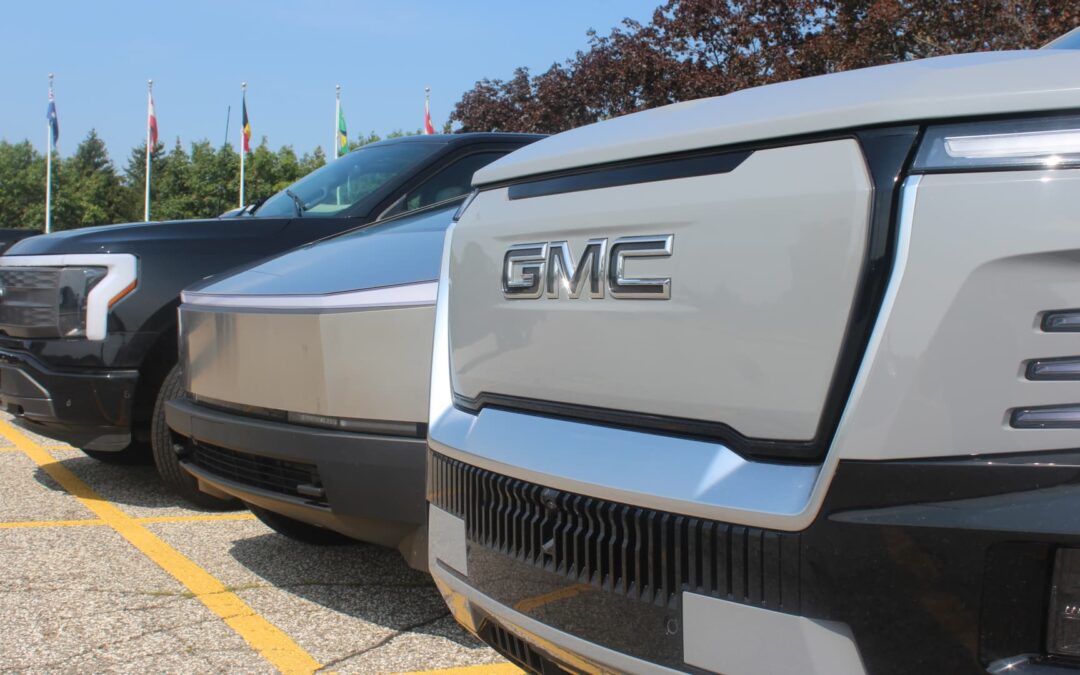Fronts of the GMC Sierra Denali,Tesla Cybertruck and Ford F-150 Lightning EVs (left to right).
Michael Wayland / CNBC
DETROIT – Tesla, General Motors, Rivian Automotive and Ford Motor have created a new market in the U.S. automotive industry of pricey, powerful and precarious electric pickup trucks that sell for $100,000 or more.
Just five years ago, the idea of a customer paying six figures for a pickup truck — historically a work vehicle meant for hauling and towing — was cause for national headlines. But it has quickly become normal, as automakers attempt to increase profits on traditional trucks and simply make a profit on electric ones.
“Customers are willing to spend, so automakers are going to give it to them,” said Stephanie Brinley, principal automotive analyst at S&P Global Mobility. “In general, pickup trucks getting more equipment, better features and better materials really just reflects general consumer attitude of wanting more.”
But unlike $100,000 traditional pickup trucks with internal combustion engines that offer superior capabilities compared with their lower-priced counterparts, electric trucks have higher price tags in part because of their technologies, including the costly batteries needed to power the vehicles.
“If you think about who’s actually buying these new EVs, it’s definitely, for the [automakers], a different demographic,” said Stephanie Valdez Streaty, Cox Automotive director of industry insights. “These are very expensive, very niche vehicles.”
There are currently a handful of electric trucks for purchase in the U.S. market: the Tesla Cybertruck, Ford F-150 Lightning, Rivian R1T and General Motors’ GMC Hummer EV, GMC Sierra Denali and Chevrolet Silverado. The GMC Hummer and Rivian also have SUV versions, which feature similar functions as their pickup counterparts but in different forms.
All those vehicle can get close to or easily top $100,000, including Tesla’s “Cyberbeast” model for about $120,000 and a limited-edition GMC Hummer for more than $150,000. Kelley Blue Book reports both vehicles transacted for over $100,000 last month — and the Tesla Cybertruck became the best-selling vehicle in the U.S. priced at six figures or more.
That compares to the average price paid for a traditional full-size pickup of $65,713, including average discount incentives of 7%, according to Kelley Blue Book.
Overall, this electric “truck” market, including the SUVs, accounted for nearly 58,000 vehicles sold during the first half of this year, according to estimates from Motor Intelligence. That’s less than 1% of the roughly 7.9 million light-duty new vehicles sold during that time in the U.S., but a 35% quarterly increase from the first to the second quarter, according to the data.
The market is expected to keep growing, but for now I’ve driven each of those $100,000 vehicles for varying amounts of time. They all drive and handle well, but in varying ways. Here are some thoughts on each:
Tesla Cybertruck
The Tesla Cybertruck is in a league of its own when it comes to pretty much everything — design, function, polarization and features.
It is far more “cyber” than “truck.” It indeed has some truck capabilities, such as a pickup bed and other utilitarian features, but it is not a truck in any traditional sense of the word.
A Tesla Cybertruck near General Motors’ Renaissance Center world headquarters in Detroit.
Michael Wayland / CNBC
The Cybertruck features tight steering, including a yoke and “steer-by-wire” system; a stiff chassis similar to a sports car; and, while arbitrary, a design that is far more form than function, which is historically one of the top reasons to purchase a pickup truck.
The Cybertruck, like its GM competitors, also features “four-wheel steer” in which all the vehicle’s wheels assist in its turning. Compared with a traditional vehicle where two wheels turn the vehicle, it makes larger vehicles much easier to maneuver.
What the Tesla Cybertruck lacks in traditional “truck-ness,” it makes up for in technology, as well as the human-machine interface, or HMI, of the vehicle with the driver.
The vehicle is arguably an experiment for the company in many ways regarding its technologies.
- Pros: Design, technology, software, weight (lowest in segment), four-wheel steer
- Cons: Design, bed access, interior space and quality
GMC Hummer EVs
The GMC Hummer EV — the first electric truck to hit the market — is the most comparable to the Cybertuck in terms of performance, price and overall gaudiness.
Driving the vehicle, whether it’s on- or off-road, is an experience. GM has called it the world’s first “supertruck.” It is fast, large and the least efficient consumer EV on sale today, according to the U.S. Environmental Protection Agency. The SUV version is smaller and more manageable to drive than the pickup truck version.
Both Hummer variants carry the weight of GM’s rapid development of vehicles. They’re heavy — estimated at nearly 9,200 pounds for the pickup — compared with every other consumer vehicle on today’s market, including their all-electric truck counterparts.
GMC Hummer EV Edition 1
Michael Wayland / CNBC
While the Hummer EVs can achieve 0-60 miles per hour in 3.5 seconds or less and are extremely capable with their performance parts, the weight of the vehicles can easily be felt when driving them.
GM’s designers did a nice job of modernizing the Hummer’s exterior design for the new EVs, including the ability to remove roof panels. But the interior can feel, much like the vehicles themselves, very bulky.
- Pros: Design, capability, durability, four-wheel steer, hands-free Super Cruise advanced driver-assistance system
- Cons: Design, efficiency, bulky interior, range
Chevy Silverado and GMC Sierra
GM’s newest all-electric pickup trucks are the Chevrolet Silverado and GMC Sierra Debali, both offering high-end models that cost nearly $100,000.
While the GM design team did an exceptional job of separating the looks of the vehicles to appeal to their respective brands, the parts and functionalities of the vehicles are largely the same.
A Tesla Cybertruck and GMC Sierra Denali EV First Edition next to one another.
Michael Wayland / CNBC
Both vehicles have an EPA-rated range of 440 miles and offer up to 754 horsepower and 785 pound-feet of torque. Important for many truck customers, they also tow up to 10,000 pounds and can charge for 100 miles in roughly 10 minutes with a DC Fast Charger (as long as you can find a compatible charger).
The Sierra is more refined and luxurious than its Chevrolet counterpart: It has open pore wood, larger total screens, GMC’s “crab mode” with four-wheel steering — shared with the Hummer — and other features.
A unique standout feature of the Silverado and Sierra EVs compared with others is the capability of a “midgate,” in which the back seats of the vehicle fold down and the back glass can come out to create a nearly 11-foot-long truck bed and segment-leading cargo area.
Both the Silverado and Sierra EVs drive well and feel like a “truck” but also remain far heavier than their non-GM competitors.
- Pros: Capability, charging speed, range, Super Cruise, midgate, four-wheel steer
- Cons: Efficiency, interior (mainly Silverado), weight
Rivian R1T and R1S
Rivian’s flagship R1T pickup and R1S SUV remain standouts in the electric truck segment when it comes to outdoor adventure and lifestyle vehicles — emulating the likes of Jeep.
The second generation of the vehicles, which were released earlier this year, improved on the ride and quality of the trucks. The R1S driving experience was noticeably smoother than the first generation of the vehicles.
2025 Rivian R1T and R1S
Rivian
While the exterior designs of the vehicles were largely unchanged for the second generation, Rivian says they deliver 10 times more computing power than before. The company also has changed more than half the hardware components.
Where the R1T and R1S truly stand out are their interior designs. They’re minimalistic, much like Tesla products, but still have enough other controls to appease mainstream, traditional buyers. The functionality and HMI also are impressive.
- Pros: Design, software, interior
- Cons: Charging speed capability, no four-wheel steer, advanced driver-assistance system
Ford F-150 Lightning
The F-150 Lightning is the most approachable all-electric truck on the market. That includes its starting price of about $63,000, driving dynamics and functionality. It largely operates like a traditional F-150 — but it’s electric. That’s because it shares many parts with its internal combustion engine siblings.
When the F-150 Lightning hit the market, it was the first “mainstream” electric truck. It followed the Hummer “supertruck” and Rivian R1T, but it was the first true test of such an all-electric vehicle for traditional truck owners.
An electric Ford F-150 next to a Tesla Cybertruck in front of Ford’s world headquarters on Aug. 27, 2024 in Dearborn, Mich.
Michael Wayland / CNBC
At launch, the vehicle was a standout, but the competition has largely caught up to it or exceeded it when it comes to range, driving dynamics and overall performance, especially when comparing it to the $100,000 trucks above.
The F-150 Lightning, which can top $90,000, remains a solid vehicle but for buyers seeking to spend around $100,000 or more, the competition is far more intense than it was when the truck launched in 2022.









